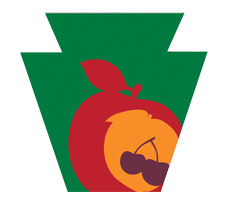Farm Show Apple Facts
Teachers! Enter Your Student's Art!
Here’s how one lucky K12 classroom can see its design at the next Farm Show!
- Print off a copy of the template by clicking here. Use this template to ensure the art fits on the mural board… and to ensure the art is legible!
- Have a contest for your students to design the most creative mural.
- Up to three student entries per school will be allowed to compete.
- To submit your classroom’s designs, scan or photograph the designs and send them to paapplemural@gmail.com by July 15, 2024. (If you prefer to send color copies by the USPS or want an address to upload them instead of emailing them, drop us a note.) Please include your name and how to reach you during the summer break with your entries.
- Our panel of judges from the State Horticultural Association of Pennsylvania and Penn State Extension will select the winning design and will work with your class to see it realized at the show.
- The winning classroom will be invited to help build the apple mural and be interviewed by the press! We provide all the fruit and maintenance during the show.
Students! Tips For Drawing Your Mural

- Making a mural is a challenge! The board is equivalent to a 55×32-pixel image: giant, apple-sized pixels!
- Sketch ideas lightly on the template provided or on plain paper first. Or use a paint app or Minecraft blocks with a 55×32 canvas. Just remember the Erie notch in the upper left and watch the weird right side of the state.
- Once you’re happy, trace the design by coloring in the matching circles using the four apple colors listed at the bottom. Each circle represents one apple.
- Mess it up? Don’t like it? No worries! Download a fresh one from the QR code at the bottom of the page.
Not A Teacher or a Student?
- Anyone is welcome to submit a design! Just follow the same directions above!
Learn More About PA Apples!
- Apple season in Pennsylvania generally begins in August and continues through early November. Gala and Honeycrisp are two popular early season apples, and Pink Lady and Fuji are two popular late season apples. Many varieties will maintain great eating quality through the spring if kept in cold storage.
- Red Delicious, the deep red apple that is used in the PA Farm Show mural, was the most popular apple in the US for over half a century. It was discovered in the late 1800s, and its mild, sweet flavor and attractive shape and color gained it its popularity. It can be identified by its deep red color and tall, conical shape.
- Golden Delicious, the yellow apple that is used in the PA Farm Show mural, is a large, sweet apple that is harvested in mid-September in Pennsylvania. Discovered in West Virginia in the late 1800s, it gained popularity as a multi-use apple. Goldens are a great choice for both snacking and baking. The Golden Delicious has also been important in the discovery of new varieties. It is a parent to the current most popular variety in the US, the Gala.
- Granny Smith, the bright green apple that is used in the PA Farm Show mural, is a tart apple that can be used in sauce, pies, or for snacking. It was discovered in Australia by its namesake, Mrs. Maria Smith, in the late 1800s, but it did not become popular in the US until the 1970s. It is ready to harvest in late October in Pennsylvania.
- Pink Lady, the apple featured to spell the words Farm and Show in this year’s mural, has bright white flesh that is slow to oxidize, which means it doesn’t turn brown once cut! That makes it a great choice for slicing for kids’ lunches, salads, and snacking!
- The color of an apple depends on three pigments: chlorophylls, carotenoids, and anthocyanins. Chlorophylls are green pigments, and these are responsible for photosynthesis throughout the season. Carotenoids are yellow, orange, or red pigments, and anthocyanins are red, blue, or purple pigments. Generally, as an apple matures on the tree, the chlorophyll levels decrease and the carotenoid and anthocyanin levels increase, giving many apples their red color.
- The skin is the most nutritious part of the apple fruit. Studies have shown that eating an apple with its peel will provide up to 332% more vitamin K, 142% more vitamin A, 115% more vitamin C, 20% more calcium, and up to 19% more potassium than eating the apple without its peel.
- Apples are a great source of fiber and nutrients. Pectin is a soluble fiber found in apples that is good for the digestive system and can help lower bad cholesterol. One medium apple provides 3 grams of fiber. Apples are also a great source of phytonutrients, antioxidants, and vitamins. One apple has about 10% of your daily recommended intake for vitamin C. Apples also have high amounts of quercetin, which is a phytonutrient with antioxidant and anti-inflammatory effects.
- There are 2,500 varieties of apples grown in the US and 7,500 varieties grown throughout the world. Only around 100 of these varieties are grown commercially in the US. Visit a local farmers market to try some new varieties!
- Most fruits and vegetables were once flowers that had to be pollinated, and apples are no exception. Apples are unique, though, in that their blossoms must be pollinated with pollen from a different variety; they cannot pollinate themselves. Because of this, apples grown from seed are going to look different than the apple that the seed came from. Just like we all have two parents and look different than our parents, apples are the same way!
- Have you ever wondered how there are so many different varieties of apples? The original apple farmers in the US were homesteaders. Since these apples were grown from seed, and since each seed is a unique combination of two parents, there were thousands of different varieties being grown in people’s backyards. From these trees, the best tasting apples could be selected and grown through a process called “grafting.” By cutting a bud from the original tree and placing it on a new tree, you can produce another tree that is identical to the original. Over time, the best quality apples have been reproduced by this process.
Wherever you live, there is likely a farm or store where you can buy fresh, delicious apples grown locally in PA. Please buy local apples and support your local farms!
